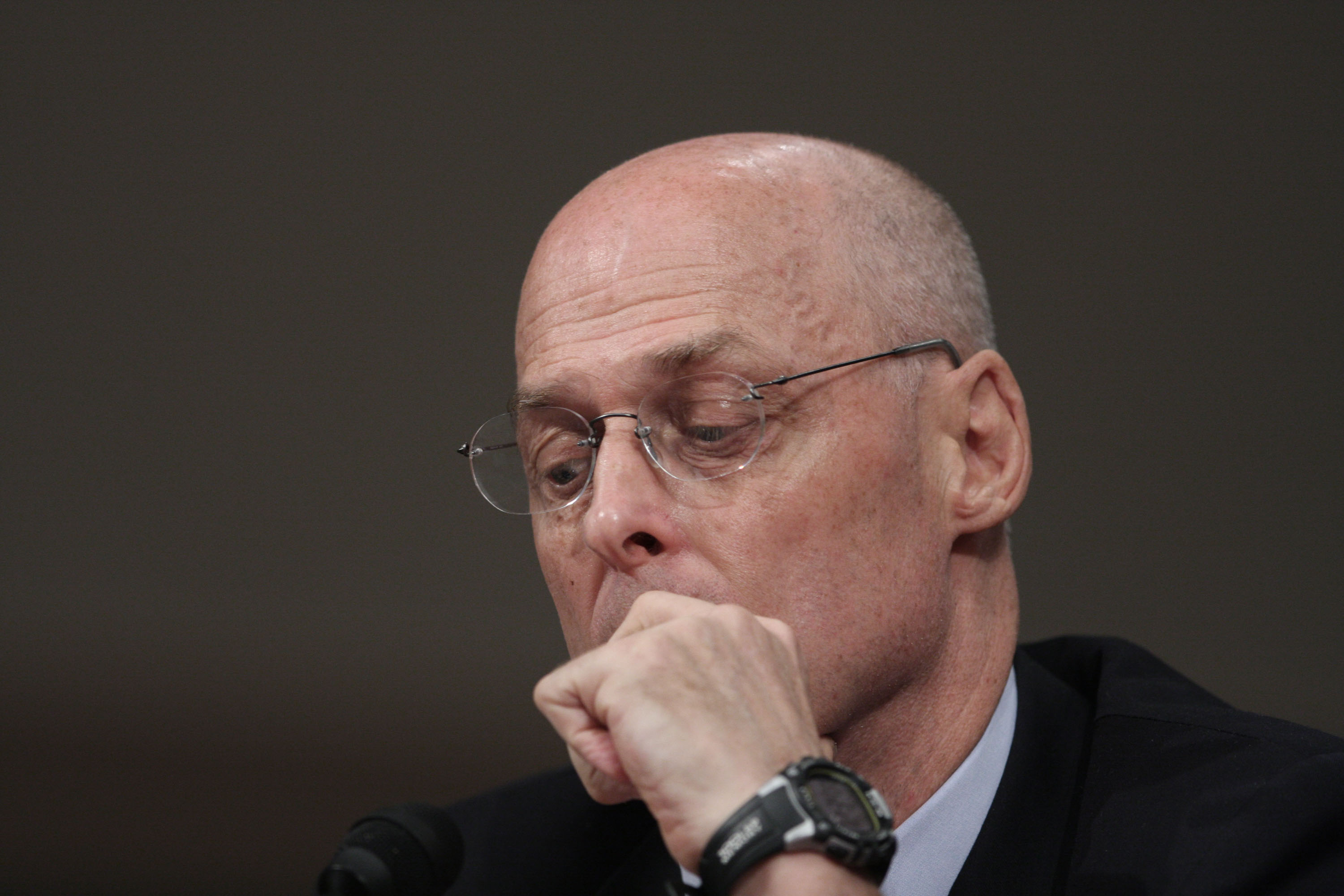Hyperventilating on the Bailout « The Washington Independent
Jul 31, 20201.8K Shares604.2K Views
Treasury Secretary Henry Paulson (WDCpix)
Congress’s failure to pass the Bush administration’s financial plan has triggered a wave of scare commentary -– “financial Armageddon,” a leap “off the cliff” or “into the abyss,” the trigger for “the Depression of the 2010s.”
There have been good background analyses of the $700 bailout plan in both The Economistand The Wall Street Journal. Two weeks ago, after Federal Reserve Chairman Ben Bernanke and Treasury Sec. Henry Paulson Jr. refused to rescue Lehman Brothers from bankruptcy, they were shocked at the subsequent reaction in credit markets. Sorting out claims was far harder than expected, and the losses on Lehman paper had a nasty snapback on supposedly safe money market funds.
Illustration by: Matt Mahurin
Shaken, Bernanke and Paulson decided that they couldn’t risk any more major bank failures. Instead, they decided to re-capitalize the industry by buying up its bad assets. The $700-billion price tag was just a guess. The terms of the purchase were intentionally loose to make it an offer that the banks couldn’t refuse, or even haggle over.
Paulson was called “The Hammer” on Wall Street. In a classic “bear hug” acquisition, you stampede the target’s board by the early release of an attractive proposal to shareholders. He used the same tactics with the U.S. Congress. To less effect.
By announcing the bailout to the public even before the congressional briefings, Paulson counted on, and got, a huge market recovery. He was essentially daring Congress to turn him down. But it did.
The plan was misrepresented from the start. The core problem is that banks are carrying toxic assets at far more than their true market value. If they mark them correctly, however, the accounting losses will wipe out their capital.
So the only way a bailout can “recapitalize” them is by vacuuming up the bad assets at much more than their true value. Taxpayers will get some money back at some point — but not much.
Nor does the plan have anything to do with preventing a recession. Major-market house prices more than doubled from 2000 through 2005; that’s about a 14 percent annual growth rate, the highest on record. If you bought a house with 1 percent down, which was easy, you got your investment back sevenfold in just three years!
With the value of the underlying assets growing so fast, banks lent to anyone on anything, and mounted second mortgage marketing campaigns to get current homeowners to cash in their paper gains. There were similar, if smaller scale, bubbles in corporate takeover loans, commercial real estate and auto loans.
Home-equity loans paid for 6 percent of all consumer spending from 2000-2007. Now that consumers are maxed out on debt and house prices are dropping back toward normal levels, that source of cash is gone. Consumer spending must go down — a lot. That’s why we’re in a recession, and the bailout can’t do much, if anything, about it.
How many votes would the bailout plan have gotten if the administration and the congressional leaders had told the truth — that this is a bank bailout that won’t prevent a recession or help homeowners?
Saleability aside, is the Bernanke-Paulson plan really such a good idea? One leading economist insiststhat it’s necessary to avoid the “destructive power of deleveraging.”
But excessive leverage is what the crisis is all about. Deleveraging, however painful, is the solution, not the problem.
Today, panicky interbank markets pushed the overnight lending rates to 7 percent. But a quarter-century ago, then-Federal Reserve Chairman Paul Volcker intentionally pushed the overnight lending rate to 19 percent(!). He had chosen to spike inflation by choking off the supply of money and credit, knowing that he would trigger a vicious recession.
Real gross domestic product dropped 1.9 percent in 1982 — the worst downturn in postwar history. President Ronald Reagan, Republicans might note, supported Volckerall the way. Together, they laid the groundwork for the strong growth of the 1980s and 1990s.
Bernanke and Paulson talk about a recession as if it’s the equivalent of a nuclear holocaust. It’s not.
The whole country has grossly overspent its income for the last half decade and is wallowing in unpayable debt. The leveraging-up process has also created a bloated and omnivorous financial sector that needs to be shrunk drastically.
In short, it’s about the same scale of problem that Volcker faced in 1982, and warrants similar resolve. Many banks will doubtless fail without the bailout, with possibly severe short-term consequences. The long-term cost of a zombie financial sector on life support might be even higher.
The bailout was a questionable idea at best, made worse by the ram-through attempt and the misleading sales pitch. And neither presidential candidate has any stake in delaying the start of a recession until he takes office, and gets stuck with the blame.
So Congress did the right thing. It’s time to let the bailout die.
Charles R. Morris, a lawyer and former banker, is the author of “The Trillion Dollar Meltdown: Easy Money, High Rollers and the Great Credit Crash.” His other books include “The Tycoons: How Andrew Carnegie, John D. Rockefeller, Jay Gould and J.P. Morgan Invented the American Supereconomy” and “Money, Greed, and Risk: Why Financial Crises and Crashes Happen.”

Hajra Shannon
Reviewer
Latest Articles
Popular Articles

